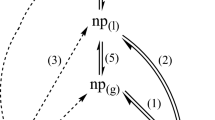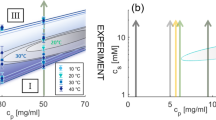Abstract
Circular dichroism, ellipsometry and radiolabeling techniques were employed to study the induction of changes in the secondary structure of BSA, myoglobin and cytochrome C by a hydrophobic surface. The results showed that adsorbed protein molecules lose their ordered native structure in the initial stage of adsorption and the structure appears to be a random or disordered conformation. Protein molecules adsorbed in later stages adopt a more ordered secondary structure (α helix and β structure). The changes of secondary structure of globular proteins induced by a hydrophobic surface can be explained by the steric interaction between adsorbed proteins as well as by hydrophobic interactions during the adsorption process. In addition, there is obviously an intermediate stage in which the protein molecules are mainly in the β structure, indicating that for certain proteins, the β structure may be a more stable secondary structure than α helix on the hydrophobic surface.
Similar content being viewed by others
References
Horsley D, Herron J, Hlady V, Andrade JD (1991) Fluorescence quenching of adsorbed hen and human lysozymes. Langmuir 7(2): 218–222
Kop JMM, Cuypers PA, Lindhout T, Hemker HC, Hermer WT (1984) The adsorption of prothrombin to phospholipid monolayer quantitated by ellipsometry. J Biol Chem 259(22): 13993–13998
Lee SH, Ruckenstein E (1988) Adsorption of proteins onto polymeric surface of different hydrophilicities — a case study with bovine serum albumin. J Colloid Interface Sci 125(2): 365–379
Lenk TJ, Horbett TA, Ratner BD (1991) Infrared spectroscopic studies of time-dependent changes in fibrinogen adsorbed to polyurethanes. Langmuir 7(8): 1755–1759
Lu DR, Park K (1991) Effect of surface hydrophobicity on the conformational changes of adsoraed fibrinogen. J Colloid Interface Sci 144: 271–281
Reddy GL, Nagaraj R (1989) Circular dichroism studies on synthetic signal peptide indicate β-conformation as a common structural feature in highly hydrophobic environment. J Biol Chem 264: 16591–16597
Schmidt CF, Zimmermann RM, Gaub HE (1990) Multilayer adsorption of lysozyme on a hydrophobic structure. Biophys J 57: 577–588
Soderquist ME, Walton AG (1980) Structure changes in proteins adsorbed on polymer surface. J Colloid Interface Sci 75: 386–398
Stevens L, Townend R, Timasheff SN, Fasman GD, Potter J (1968) The circular dichroism of polypeptide films. Biochemistry 7(10): 3717–3720
Wu H, Sui SF (1992) Adsorption of bovine serum albumin at the solid/liquid interface quantitated by in situ ellipsometry. Acta Biophys Sinica 8(2): 245–251
Author information
Authors and Affiliations
Additional information
Correspondence to: S.-F. Sui
Rights and permissions
About this article
Cite this article
Wu, H., Fan, Y., Sheng, J. et al. Induction of changes in the secondary structure of globular proteins by a hydrophobic surface. Eur Biophys J 22, 201–205 (1993). https://doi.org/10.1007/BF00185781
Received:
Accepted:
Issue Date:
DOI: https://doi.org/10.1007/BF00185781




